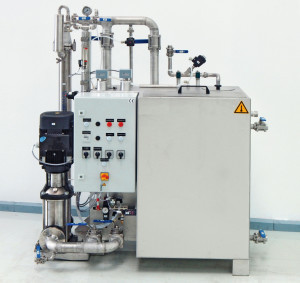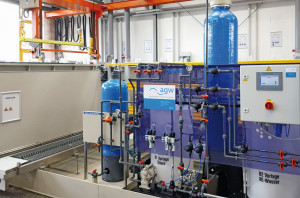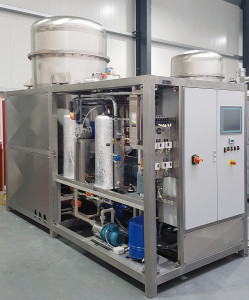With rising raw material and energy prices, efficiency and economy are becoming increasingly important. Environmental protection is a desirable by-product of the conversion of plant equipment.
 Fig. 1: KOMPalox microfiltration systemForseveral yearsnow,the surface technology industry has been struggling with price increases for raw materials that threaten its very existence, a situation that is exacerbated by the current rise in energy prices. In order to remain competitive, there is no way around optimizing the processes used.
Fig. 1: KOMPalox microfiltration systemForseveral yearsnow,the surface technology industry has been struggling with price increases for raw materials that threaten its very existence, a situation that is exacerbated by the current rise in energy prices. In order to remain competitive, there is no way around optimizing the processes used.
In simple terms, surface technology is quite straightforward - a coating of metal, polymer or other chemical compounds is applied to a raw product. However, a more detailed look at this process reveals a large number of cost factors. The costs are roughly divided into primary costs such as coating material and system costs. However, these are greatly increased by secondary costs. These include
- Energy costs (cost increases of up to 300 % in 2022)
- Loss of coating material, e.g. nickel, due to the rinsing water (nickel price increase 2020 - 2022: approx. 100%)
- Loss of treatment chemicals, e.g. sulphuric acid during anodizing
- Loss of chemicals due to carryover
- Waste of chemicals due to contamination
- Disposal costs for hazardous waste (electroplating sludge)
In order to reduce production costs, secondary costs should be reduced. Positive side effect: the economic constraint also supports environmental protection.
 Figure 2: Rinsing criterion 10,000 cascades
Figure 2: Rinsing criterion 10,000 cascades
 Fig. 3: KomParet retardation systemExemplaryprocesses that are suitable for minimizing secondary costs include extending the service life of degreasing baths through particle filtration, microfiltration (Figure 1) and ultrafiltration. Cost reductions can also be achieved by saving rinsing water through optimized rinsing technology, in this case cascade rinsing technology (Figure 2). A system for recovering process chemicals by means of retardation, such as sulphuric acid during anodization, is shown in Figure 3 . In addition, metal recovery from rinsing water and return to the process bath via ion exchangers and/or evaporation (Figure 4) is possible. Heat recovery from process baths can also reduce secondary costs. Further potential savings:
Fig. 3: KomParet retardation systemExemplaryprocesses that are suitable for minimizing secondary costs include extending the service life of degreasing baths through particle filtration, microfiltration (Figure 1) and ultrafiltration. Cost reductions can also be achieved by saving rinsing water through optimized rinsing technology, in this case cascade rinsing technology (Figure 2). A system for recovering process chemicals by means of retardation, such as sulphuric acid during anodization, is shown in Figure 3 . In addition, metal recovery from rinsing water and return to the process bath via ion exchangers and/or evaporation (Figure 4) is possible. Heat recovery from process baths can also reduce secondary costs. Further potential savings:
- Use of "waste heat" for recycling into processes or for heating
- Heat recovery (exhaust air, cooling water after-run)
- Recycling of waste as a valuable material (aluminum pickling as a precipitant)
- Use of waste heat or cooling water for thermal treatment plants.
Costs and benefits of recovery measures
From an economic point of view, recovery measures initially represent increased costs, i.e. the costs of investment and operation of the recovery plants. However, savings can be made by reducing the amount of plating materials required, e.g. nickel and copper, extending the service life of process solutions, reducing the amount of waste produced, e.g. electroplating sludge, minimizing water and energy requirements (gas, electricity) and transforming waste into recyclable materials. Other positive side effects include the reduction of the so-called "carbon footprint"
Prerequisites for recovery measures
 Fig. 4: Ion exchanger To implement such measures, different areas of production must be involved. Without close cooperation between production, building technology, supply and disposal technology, heat recovery measures, for example, cannot be implemented optimally. It should also be noted that the coupling of different areas also results in corresponding dependencies, which must be taken into account during planning. Individual material flows are required for effective recovery measures. This means, for example, that existing pipelines have to be extended and material flows diverted. Extensive preliminary planning is therefore required to implement and achieve as many ecological and financial goals as possible. The basic prerequisite for this is constructive, partnership-based cooperation between all companies involved, such as: Interested party, electroplating company, chemical supplier, waste disposal company and plant constructor.
Fig. 4: Ion exchanger To implement such measures, different areas of production must be involved. Without close cooperation between production, building technology, supply and disposal technology, heat recovery measures, for example, cannot be implemented optimally. It should also be noted that the coupling of different areas also results in corresponding dependencies, which must be taken into account during planning. Individual material flows are required for effective recovery measures. This means, for example, that existing pipelines have to be extended and material flows diverted. Extensive preliminary planning is therefore required to implement and achieve as many ecological and financial goals as possible. The basic prerequisite for this is constructive, partnership-based cooperation between all companies involved, such as: Interested party, electroplating company, chemical supplier, waste disposal company and plant constructor.


